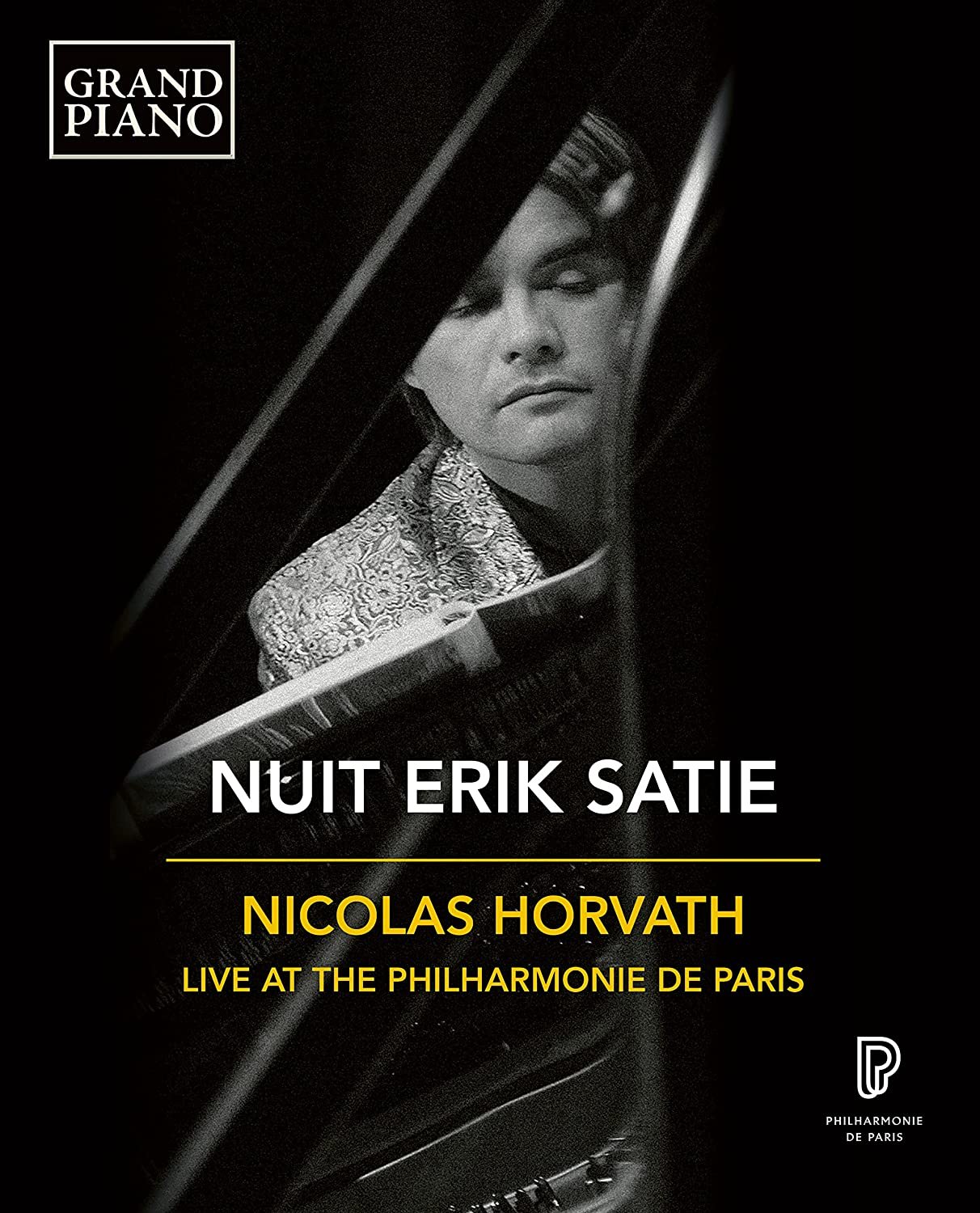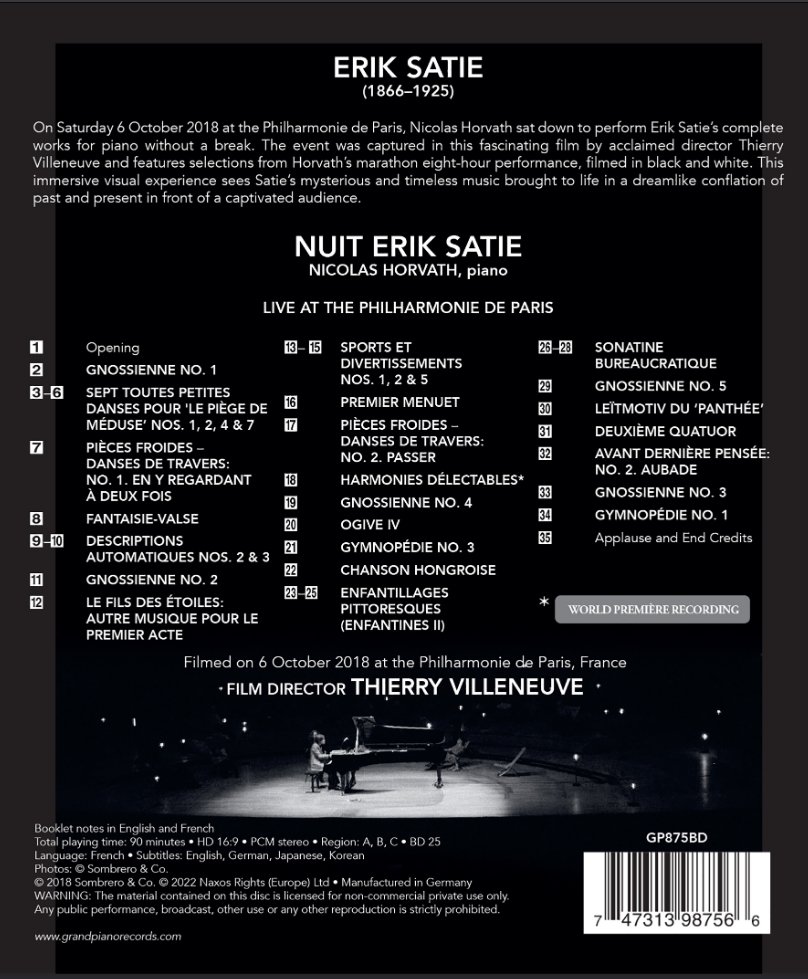

Nuit Erik Satie (Erik Satie Night) concert by pianist Nicolas Horvath. Performed October 6, 2018 at the Boulez Hall of the Philharmonie de Paris. Filmed for TV in contemplative black and white by Thierry Villeneuve. Released 2022, disc has PCM stereo sound. Grade: A+
It’s October in Paris. The tourists are gone. The days are getting shorter, grayer, and colder. Even the people of the City of Love need a little aphrodisiac. They need a Nuit Blanche at the Boulez Hall where they can hear all of Erik Satie’s, droll, philosophical, and strangely romantic piano miniatures. For up to 8 hours total.
Yes, Horvath played all of Satie’s solo piano music. The show was organized so you could get a ticket for just an hour to hear your favorite piece. Or you could stay all night. More than 14,000 people dropped by. It became a kind of civilized indoor Woodstock. But here nobody was protesting anything—just trying to get a few vibes going.
Let’s see how they did. Director Thierry Villeneuve pared the 8 hours down to a 90 minutes and added his own touches for your amusement.
It’s theater in the round as you can see from the first two screenshots:
There was special seating on the stage. Listen, sleep, read—whatever:
Next to the piano a pear and a rose. I’ve no idea what this is about, but it’s obviously important:
Two portraits of the artist:
Nobody in his right mind would try to memorize all of Satie. So Horvath plays from 3 thick books of scores:
Horvath runs through 3 page turners:
You might get tired of Satie’s music in the 90 minutes on this disc, but you will not get tired of Villeneuve’s film. He ceaselessly spices up the show with extra features that all seem strangely apt for the quaint music. Below find the Eiffel Tower and Sacré-Cœur:
A remainder that we are in the City of Love:
The Boulez hall is a fantastic symphony of modern architecture.
Villeneuve deliberately makes all kind of kinky camera errors to keep you amused as you listen to Satie’s kinky music:
Weird visual puzzles even of the center of attention-;
And throughout Villeneuve confuses you with oddball thoughts just like Satie used to do (thanks for the subtitles in English!):
If you know the history of cinema, you will maybe recognize quirky snippets from early days:
Maybe the animal closest to Satie was the spider making his gossamer traps that you almost can’t see:
The audience is trapped in dreams:
In dance:
And vibes:
I can’t image how anyone could play this music better than Horvath. Disc authorship by Grand Piano is excellent with good sound and an excellent booklet to help you find things on the disc. For decades, Satie was on my To Do list, and now I’m glad I got to him. If you are already a Satie fan, you probably know most of the music on this disc (almost 20% of Satie’s total output of piano music). But you will still want to have this amusing record of Horvath’s satieathon. There is a Heaven, and Satie is there. All day he drinks wine that can’t kill him, and each day he watches Villeneuve’s film. A+
Here’s the official trailer:
You can see the program above on the back of the keepcase. Here for the Internet spiders is the program, with valiant attempts by us at translating the names of the numbers into English:
Gnossienne No. 1 (Gnostic Notes No. 1?)
Sept toutes petites danses pour “Le piège de Méduse” (Seven Wee Dances/Seven Monkey Dances for “The Ruse of Medusa”): Nos. 1, 2, 4, 7
Pièces froides (Cold Pieces): Danses de Travers (Crooked Dances): No. 1 En y regardant a deux fois (Look at it twice)
Fantaisie-valse (Fantasy-waltz)
Descriptions automatiques (Automatic Descriptions): Nos. 2 and 3
Gnossienne No. 2
Le fils des étoiles (The Son of the Stars): Autre musique pour le Premiere Acte (Other music for the First Act)
Sports et divertissements (Sports and Pastimes): Nos. 1, 2, 5
Premier menuet (First minuet)
Harmonies Délectables (Delectable Harmonies)
Gnossienne No. 4
Ogive IV (Gothic Arch IV?)
Gymnopédies No. 3 (Nude Dancers No. 3?)
Chanson hongroise (Hungarian Song)
Enfantillages pittoresques (Picturesque Childishness), Enfantines II (Children II)
Sonatine bureaucratique (Bureaucratic sonatina)
Gnossienne No. 5
Leïtmotiv du “Panthée“ (Leitmotif for Pantheus)
Deuxième Quatuor (Second Quartet)
Avant-dernières pensées (Penultimate Thoughts): No. 2. Aubade (song warning of daybreak)
Gnossienne No. 3
Gymnopédies No. 1
OR























